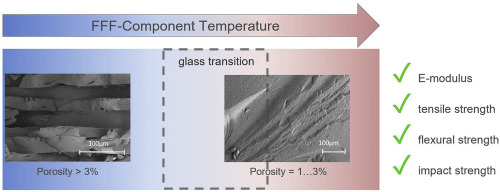Polymer ( IF 4.6 ) Pub Date : 2020-03-26 , DOI: 10.1016/j.polymer.2020.122388 Stefan Böhler , Melanie Bartel , Andreas Bohn , Ron Jacob , Johannes Ganster , Thomas Büsse , Jens Balko

|
The extrusion based Fused Filament Fabrication (FFF) enables to build up components of thermoplastic materials by using a layer-by-layer strategy. Typically, the layered structure results in an internal porosity limiting the mechanical performance. In this work, using a commercial 3D-printer specimens of the polymer cellulose acetate (CA) were produced having porosities as low as 1–3%. Quasi-static tensile tests demonstrate that these highly dense specimens reach similar or even higher strength values in comparison to their injection molded counterparts. The influence of the temperature management was studied by using different hot-ends, namely a standard one and a novel hot-end having a modified heat-block. Using the latter one, a homogeneous internal structure was achieved as observed with scanning electron microscopy. The very low porosities can be assigned to the elevated specimen temperature maintained during printing which is slightly above the materials glass transition temperature. Processing of CA at such temperatures leads to a slight loss of plasticizer as proved with NMR spectroscopy. This favorable change in material composition during printing additionally contributes to the mechanical strength of the test specimens. We conclude that the porosity is the key parameter (which has to be measured and minimized) to realize FFF components with good mechanical performance. Whereas we demonstrated FFF for the first time for CA as an industrially relevant thermoplastic material, our results can be easily applied to amorphous polymers in general.
中文翻译:

熔融长丝制造的高密度醋酸纤维素样品具有优异的机械性能
基于挤出的熔融长丝制造(FFF)能够通过使用逐层策略来构建热塑性材料的组件。通常,分层结构导致内部孔隙率限制了机械性能。在这项工作中,使用商业3D打印机制作的聚合物醋酸纤维素(CA)样品的孔隙率低至1-3%。准静态拉伸测试表明,与注塑成型的同类产品相比,这些高密度试样达到了相似甚至更高的强度值。通过使用不同的热端,即标准的热端和具有改进的热块的新型热端,研究了温度管理的影响。使用后一种,如通过扫描电子显微镜观察到的,获得了均匀的内部结构。可以将非常低的孔隙率分配给打印过程中保持的升高的样品温度,该温度略高于材料的玻璃化转变温度。NMR光谱证明,在这种温度下处理CA会导致增塑剂略有损失。印刷过程中材料成分的这种有利变化另外有助于测试样品的机械强度。我们得出的结论是,孔隙率是实现具有良好机械性能的FFF组件的关键参数(必须对其进行测量和最小化)。尽管我们首次证明了FFF是CA作为一种工业相关的热塑性材料,但我们的结果通常可以很容易地应用于无定形聚合物。



























 京公网安备 11010802027423号
京公网安备 11010802027423号